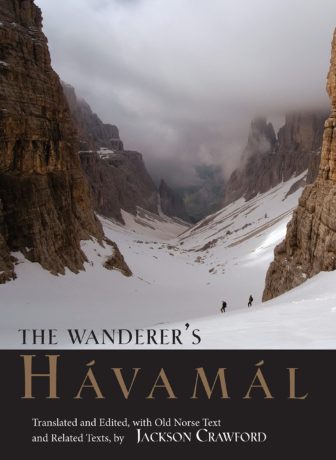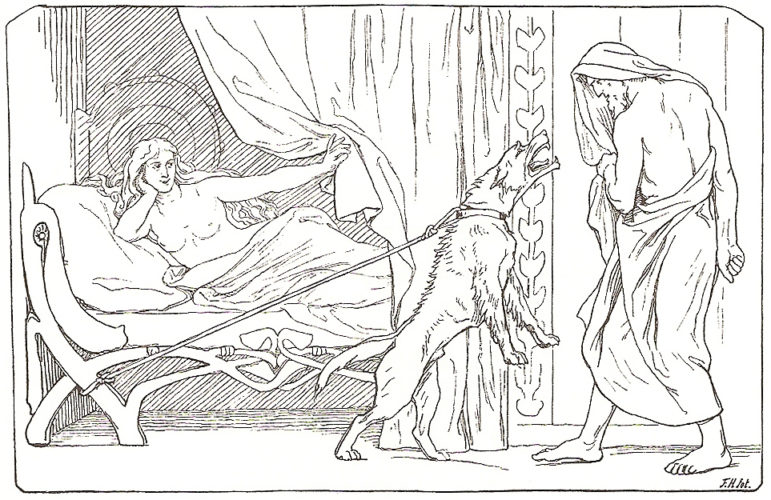
Everyone with an internet connection and at least a meager interest in vikings or Norse myth likely knows who Jackson Crawford is. His videos on YouTube, where he attempts to explain the often labyrinthine workings of Old Norse Icelandic literature and culture to the common folk, has made him practically a household name. Back when I was getting started in my studies of Old Norse in Iceland a decade ago, however, he was only really known among the very niche world of medieval Norse studies, where two of his works, an Old Norse adaptation of Star Wars as well as a cowboy-sounding rendition of parts of Hávamál were widely shared.
At that time, Crawford was putting a finishing touches on a PhD in Scandinavian studies while working on his first book: a new English-language translation of the Poetic Edda. Years before he started his YouTube channel, it was his translations, starting with this one, that put him on the map so to speak. However, unlike his later works on YouTube, this translation did not receive overwhelming praise.
Boasting no foot- or end notes to explain difficult passages, and only covering very lightly topics such as manuscript history, different versions, reception, and other contextual information, it also lacked an entire poem (axed for being redundant and too long) and was presented in a rather free form that strayed too far from the text’s original meaning according to some. Because of these lacunae, few within the field of Old Norse and Viking studies recommend Crawford’s Edda, favoring instead the works of, for instance, Larrington, Orchard, or Dronke.
It was with this kind of baggage that I, reluctantly at first, began to read Crawford’s new version of Hávamál, The Wanderer’s Hávamál.

From the get go, though, I found the book rather alluring. Small and short (176 pages), endowed with an impressive front cover, embossed text and practical cover flaps, it felt cleverly designed to be first of all very readable. Perusing then into the table of contents, I was pleasantly surprised to see that this translation came with over 20 pages of introduction (Crawford’s 2015 Edda in comparison included just a bit north of 30), Old Norse-Icelandic text, over fifty pages of commentary, as well as a couple of additional shorter texts. This boded well, I thought.
I then decided to dive right into what some consider to be one of the most important texts from medieval Scandinavia. While I had read translations of Hávamál before, I have never spent much time pondering on its wisdom, its narrative, or even its nature. Hávamál, you see, is the longest poem of the Poetic Edda but also one of the most complex. Pieced together sometimes prior to the 13th century from several possibly completely unrelated poems, it harbors countless obscure references, cryptic terms, and even typos. It is not an easy work to deal with if one wants to look at it from a scholarly perspective.
However, due to its inclusion of dozens of pieces of advice, anecdotes, and allusions to sorcery and the runes, it is also one of the most fascinating poems of the Poetic Edda, not the least for committed Heathens, Pagans, and spiritual seekers alike. How this poem is edited, translated, interpreted, and discussed is therefore a bigger deal than maybe any other poem besides Völuspá. This is why I spent a decent amount of time on each stanza, looking at the original Old Norse-Icelandic, before checking out Crawford’s translation and the relevant notes he placed towards the end of the poem.
As I slowly made my way through the poem, I started to get a better understanding of Crawford’s style. The translator, an apt linguist, clearly has a great understanding of the original Old Norse-Icelandic text, which he renders in a clean yet not overtly sanitized version. His final translation, however, often shaves off the rough edges that can be expected from archaic verse born in the depths of the Middle Ages. His rendition of sentences that would be clunky, were they to be literally translated, gets slightly rearranged with the inclusion of useful pronouns, modern idioms, and words that, if they do not purely correspond to the original, both sound good and work well enough.
Let’s look for instance, at stanza 80:
Þat er þá reynt / er þú at rúnum spyrr / inum reginkunnum / þeim er gørðu ginnregin / ok fáði Fimbulþulr / þá hefir hann bazt ef hann þegir
What you ask of the runes / will prove true / they are of divine origin / made by the mighty gods / and painted by Oðin / You’ll learn best with your mouth shut.
On the first line, Crawford gives reyna (“to prove/test/experience”) a stronger meaning as “prove true.” On the third, his translation of reginkunnum follows that of most other translators. His choice to render Fimbulþulr (“mighty þulr,” a sort of sage or seer) as Oðinn can be criticized, but in the end, the former term is nothing but an equivalence (a heiti) to the latter. Finally, the tendency of rendering third person pronouns and verbs as second person injunctions (here hann strictly means “he” without indications of who it refers to) is rather unusual but remains within the realm of a translator’s prerogative.
All in all, as you can see here, Crawford does take quite a few liberties in his language, but generally remains within a reasonable range of meaning from the original, all the while reserving his notes to explain truly obscure terms or contested readings. He thus manages to walk a fine line between explaining too little and taking agency away from the reader, and going into so much detail that it would dwarf the text itself and scare the average Joe away. So, while one can criticize his translation style, his inclusion of both the original Old Norse-Icelandic and notes explaining many of his translation choices ends up empowering the reader to a much greater extent than the version found in his 2015 Edda – though this is where a serious issue lays.

Illustration by Lorenz Frølich showing Odin encountering Billing’s daughter and her hound (1895) – Public domain
When compared to Crawford’s 2015 Edda, the Wanderer’s Hávamál makes its older sibling look rather pedestrian. One could imagine a prospective reader receiving, like I did, this book as a gift, having a blast reading it, and then end up disappointed when the complete Edda, although translated by the same author, delivers much less information, context, and resources. One could argue that it is significantly easier to go into minute details when focusing on a single poem, but other pocket translations of the Edda, like those of Larrington and Orchard, manage to cram a decent amount of commentary all the while remaining perfectly readable and modest in size. One could even posit that a reader who truly enjoy the Wanderer’s Hávamál and wants to read the entire Edda with comparable helping tools might ultimately end up choosing one of those competing translations instead.
Besides all of these more involved considerations, the Wanderer’s Hávamál still remains worth a read. Both the Heathen and Pagan searching a closer connection to the sources, the seeker who just wishes to read something inspiring, and the student who wants to get better at reading medieval Norse-Icelandic will get something out of this slim, alluring volume. Is the translation style completely accurate? Not really, but it is close enough, and the inclusion of notes and the original text will help anyone wanting to get beyond that. Is the introduction thorough enough? Maybe not quite either, but it gives enough basic facts to get started quickly. Do the additional texts (Darraðarljóð, Eiríkamál, Hákonarmál, excerpts from Gautreks saga and Crawford’s own Cowboy Hávamál) fit with the main poem? Not entirely, but they certainly don’t hurt and will probably inspire some poetry beyond what’s in the Edda.
All in all, the Wanderer’s Hávamál is not perfect, but as a popular edition and translation of one of the most significant text of the medieval Scandinavian canon and a highly revered source for modern Paganism, it does the job well enough. Go grab a copy, slide it in your back pocket, and go on a hike somewhere nice. You will have some nice reading ahead of you, I swear.
Jackson Crawford. 2019. The Wanderer’s Hávamál. Translated, with Old Norse Text and Related Texts. Indianapolis/Cambridge: Hackett Publishing Company. Softcover. US $13.50.
The Wild Hunt is not responsible for links to external content.
To join a conversation on this post:
Visit our The Wild Hunt subreddit! Point your favorite browser to https://www.reddit.com/r/The_Wild_Hunt_News/, then click “JOIN”. Make sure to click the bell, too, to be notified of new articles posted to our subreddit.